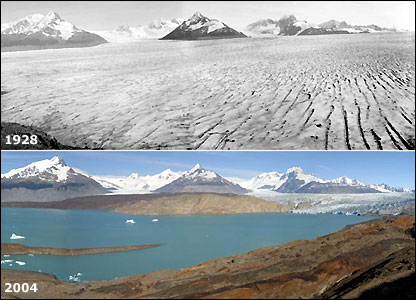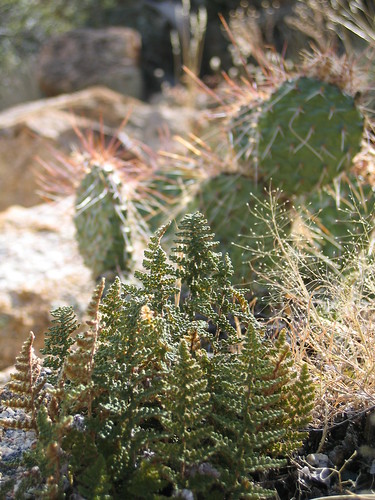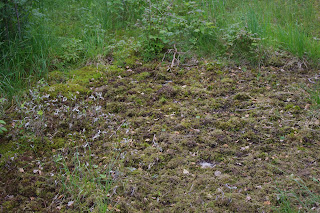 |
| Biological Soil Crusts on a Granite Rock Slab |
For the record, this is a continuation of the first article I wrote on Biological soil Crust which dealt with the strictly conventional view of Bio-Crusts by those who have a career in studying them. But the reason for this post is mainly because most people in this world find Deserts boring and of little worth, so describing the incredible unseen microbial world there can be better appreciated through the eyes looking at an environment like forests. These organisms are basically the same kind of family group. It's just that in a Boreal forest with all their obvious colour and sparkle, people pay closer attention. That is the reason for furthering the subject with this post. So here was my first post on Biological soil crusts:
Let's see now, Biological Soil Crustal mechanisms by their very definition from soilcrust.org are officially cataloged as "Major components are cyanobacteria, green algae, microfungi, mosses, liverworts and lichens." Well that would classify my backyard as a typical Biological Soil Crust Habitat , wouldn't it not ? But wait a minute, there's more to that soilcrust.org definition, take a look:
"Biological soil crusts are the community of organisms living at the surface of desert soils."
Woah, wait a minute, back up the Science Train for a moment. Why doesn't my "cyanobacteria, green algae, microfungi, mosses, liverworts and lichens" in my backyard qualify as official Biological Soil Crust ? Well I'm assuming it's because by the officially approved Panel of Peers definition such a plant community can ONLY be found in Desert Drylands. Yeeeaah and all Ferns only grow in moist lush Tropical, Temperate or Boreal Forests ONLY! Hey I didn't just fall off the Crust Truck you know. I appreciate and naturally so do many others who know me that I am not exactly your basic conventional Science Dude.
I have a habit of actually watching and observing nature and with practical applications on those observations, I tend to toss out the Ideological Assertions, Assumptions and Speculations for the FACTS as I observe them with my own eyes. I am also burned out with the way conventional science -based wisdom infected with various ideological philosophies has ruined our planet. So over the years I tend to be a healthy open minded skeptic. Sometimes that puts my understanding which has always resulted from making practical applications at odds with the conventional science follower types.
What I do know from experience and from my personal first hand observation is that things sometimes CAN be what they SEEM. The Biological Soil Crusts behind my backyard covering every exposed Granite Rock faces or shallow soils all through these Boreal Forests serve the exact same function and purpose as those Desert Biological Soil Crusts. And what is it that they do ? They make Soil, just like they do in any other varied ecological habitat around the Earth.
When I first came here I was astonished at the sheer amount of granite bedrock everywhere around western Sweden. I wondered how anything grew at all in these Forests. Obviously LOTS of water takes care of that and it rains here all the time. Now in the past when we've had some periods of no rainy days lasting for a month and a half, many of even the bigger shrubs & trees on Hissingen Island, (it's really a Penninsula - but don't ask why !!!) will die. The soils are extremely shallow here, but what soils there are come from these magnificent biological machines. Take a look at this photo below of how common it is to have wind blown over or downed trees here. The average soil is just not that deep and it doesn't take an extremely violent windstorm to topple down the trees here.

Now to give you some geological perspective of Western Sweden, take a further look at the Göteborg Archipelago where the majority of the geology is exposed to the elements. However, in some small niches on these islands, there does exist some soil and vegetation. The tree fallen over here is an example of something that occurs all of the time. The soils are just not that deep here and what little soil there is, is from biocrustal breakdown on granite rocks. Where I come from in Southern California, such soils would never even begin to support any tree. Thanks because we do not have the constant steady rainfall that they have here in Sweden.
One of the things that first struck me when I first observed this tough seemingly harsh rocky granite landscape is where did all of this soil come from in the first place ? If you listen to and believe the story that is told of the history of these particular geological formations of western Sweden with it's extremely abundant Archipelago island chain strung along all around it's coasts, is that it's formation came from the time period of when the Ice Age ended and the great Glacial receding came along and reveal this rock hard sterile looking landscape. Of course like all receding glacial landscapes, for many years there is this sterile appearance to it. Take note of this series of photos which reveals a seemingly lifeless barren landscape after glaciers disappear.
 |
| Upsala Glacier, Argentina 1908 to 2004 |
 |
| Krossfjorden, survey of Fjortende Julibreen Glacier |
Spores of all these Lichens, Algaes, Mosses and various forms of fungi need to enter the scene first to create a foundational Soil system for the succession of life to begin. A clue for me on how this soil could have developed over time came from that top photo on this page. There was just something interesting I noticed.The rock face with the bio-diverse colonies of Lichens, Mosses, Algaes and Fungi/Bacteria was pock marked in a sort of checker board pattern and I wonder why and what could have done this. Take a closer look:
Now if you look closely, you'll see the area is clearly pockmarked as of some bird or animal were foraging around for some sort of sustenance. Of course the number one bird around here for this is the Magpie, but there is also a very large wild breed of pigeon which will graze areas in large groups as well. The nice side effect this has is constant turn over of organic matter. But no harm done as with the massive amounts of moisture received here, the mosses and lichens rapidly repair themselves in no time.
Clearly you can see something has foraged around and turned over some of the mosses looking for earthworms or sowbugs, both of which are abundant underneath this layer of living biological material. Below, let's take a closer magnification look at has happened exactly. These birds, Magpies, Jackdaws, Black Birds and even the large Forest Pigeaons which are quire shy are heavy feeders, especially in Springtime where they have young. After that their foraging habits tapers off, well except for the Magpies.
 |
| Photo: Mine |
 |
| Photo: Mine |
 |
| Photo: Mine |
 |
| This build up here is about 10 inches thick just from this season |
This next bird is not just your common black bird. It is much larger and the male seen here with the yellow ringed eye and orange beak sings like a Western Thrasher or Mockingbird for those familiar with them, The female is dull sooty brown with dull brown beak. The male's singing is beautiful and echoes everywhere through the forest. The are ground foragers like the Pigeons and pick through the easy to turn over mosses and lichens. Actually, both the males and females are heavy foragers.
This next bird is probably more recognizable to most as they are found not only throughout northern/central Europe, but across North America and Asia in Siberia. We know it as the common Magpie, but they also are ground foragers and are often picking and turning over the mosses and lichens here. With that in mind, let me show you some other images of just where all of these Biocrustal Colonies love to show up here in Sweden. Actually anywhere they want. Often times houses with the clay-tile or stone roofs will need replacing if old enough. That's because on the north sides of roofs there are usually heavily encrusted mats of these lifeforms eating and chewing their way through the mineral material. After all, that's what they do. They also chew through headstones at the Cemeteries here and I have some photos of this. People after some decades will have to replace a family member's headstone if it has been severely damaged and crumbled by these crusts. These first two pictures are from the surrounding walls of one cemetery just to illustrate their prolific ability to colonize just about anywhere.
 |
| Photo: Mine |
These next
pictures are examples of grave stones. when my wife's grandmother died
and we went up north for the funeral in this little small town with a
small church with an attached cemetery, which was very very old, the
wear patterns on the granite stones were extremely well worn and these
living things were responsible for this break up of tough mineral rock
material. Like the man made material of concrete and such, nothing is
safe from these biological mineral breakdown machines.
 |
| Photo: Mine |
 |
| Photo: Mine |
 |
| Photo: Mine |
 |
| Photo: Mine |
 |
| Photo: Mine |
 |
| Photo: Mine |
 |
| Pink Waters- Lake Retba in Senegal |
What will they now do as a means of maintenance with these places ? Once the soil is stripped of their Biological Soil Crusts in these deserts, dust storms become far worse. As a means of maintenance, these companies cannot allow and biological growth in between these solar panels or other wind-energy units. Yet like the Oil Companies who create moonscapes inside of their oilfields for a purpose, then Eco-Not-So-Green Companies will most likely employ some of the same methods used by the Big Corporate Oil Industry to sterilize the soil around their oil wells. Ever see a sterilized looking oil field ? Wanna know why they are sterilized ?
 |
| Oil Fields No. 1, Belridge, California 2002 |
You'll first off take note that I did NOT pull a picture out from a Saudi Arabian Desert Magician's black Top-Hat here. This is Belridge California. First off it should be noted that Oil Companies CANNOT afford to have dry grasses or anything else to facilitate the movement of a grass fire inside ANY of their fields.
When I worked for Coors Bio-Tech back in the late 1980s, we had an Orange Peel Solvent much like the picture here to the right called Bio-T Max. It is known by another name in the chemical industry called D-Limonene. It is water soluble and has numerous practical cleaning and degreasing applications. As a Manufacturing Representative for Coors Bio-Tech (yes the same Golden Colorado Company that makes Beer) it was my job to canvas for official distributors for this product. One of these was a Chemical Distributor of products to the Oil Industries from Santa Barbara to Bakersfield California. Very well known oil producing areas to many. Even Santa Barbara off the coast.
This chemical distributor even sold an incredibly industrial strength chemical herbicide that guaranteed his oil company clients that the herbicide would destroy all biological life on and under the ground and on top of the soil and prevent any weed seeds from germinating on that site for at least 7 years. I bet most of you didn't know this kind of stuff even existed. Monsanto created Agent Orange for the Vietnam War as a Tropic Forest defoliant for which these areas today are still mostly desert regions. And yet these Oil Companies still need or require a strong chemical sterilizer to keep fields plant life free. Only a Armageddon sized event will stop it
 |
| Photo from Landscapes by Cochran Inc |
 |
| Landscapes by Cochran Inc. |
Terra Derm: Restoring Soils on a Global Scale
 |
| Images from Terraderma |
The facts here show and prove that there are many many amazing things out there in the natural world yet to be discovered, researched and understood for use as a practical application for proper custodianship of this Earth. No matter what or how we want to define these amazing organisms, or what personal professional bias we have on these subjects, the work with which they accomplish everywhere around our planet Earth should be admired by everyone. To that end I hope I've made an otherwise boring science subject fascinating to the average person.












No comments:
Post a Comment
Thanks for visiting and stopping by with your comments!
I will try to respond to each comment within a few days, though sometimes I take longer if I'm too busy which appears to be increasing.